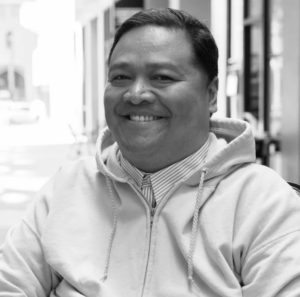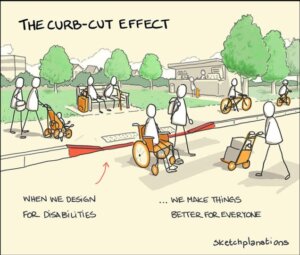 My foray into the world of accessibility began over a decade ago during my time as a lead content strategist for a large online bank, in the enterprise division. I was quickly inundated with a slew of acronyms like ARIA, A11y (=Accessibility), WCAG, W3C, and VPAT. At first, the weight of the responsibility and the amount I needed to learn was overwhelming, but what I didn’t know then was that it would ignite a passion for creating equitable experiences in a way I had never before had access to.
My foray into the world of accessibility began over a decade ago during my time as a lead content strategist for a large online bank, in the enterprise division. I was quickly inundated with a slew of acronyms like ARIA, A11y (=Accessibility), WCAG, W3C, and VPAT. At first, the weight of the responsibility and the amount I needed to learn was overwhelming, but what I didn’t know then was that it would ignite a passion for creating equitable experiences in a way I had never before had access to.
The fintech company had invested in the expertise of an accessibility specialist, often bringing her into projects at the end. As a content strategist, I was accustomed to close collaboration with various disciplines, and this approach puzzled me. I quickly realized how frustrating it was for our accessibility specialist. It made no sense that accessibility was not embedded from the start. As a content strategist, I became responsible for creating the content that screen readers would read for images.I I began to understand the intricate pieces that make a platform truly accessible, and everything I learned there is still applicable in my role today.
Evolving with Product Accessibility in UX
As the senior director of user experience and product design at Accela, I still leverage what I learned writing alt-tags, skip links and labels over a decade ago. But as the landscape of the govtech industry evolved, so has our approach to accessibility. In many enterprise companies like ours, product accessibility sometimes shifts under the purview of UX and design. When this first happened at Accela in 2018, we didn’t have an accessibility specialist on staff, and it was a big transition for me and my team. We began by finding the right training for our UX team, designers and design technologists—though a tremendous undertaking, in the long run it has allowed us to integrate accessibility best practices directly into the design phase.
We know that the responsibility of creating accessible software falls not just on UX, but on everyone in the product life cycle. So, over the past few years, we have broadened the pool of accessibility advocates and experts to include product managers, developers and quality assurance engineers. Accessibility is no longer an afterthought but an integral part of our design philosophy, ensuring that our products are built to serve everyone, inclusively.
Embracing Inclusive Design
Our commitment to accessibility goes beyond mere compliance.Inclusive design is at the heart of our ethos, shaping our approach to the design and testing process. By empathizing with users of diverse backgrounds and abilities, we can uncover valuable insights that lead to innovative solutions. Inclusive design fosters creativity and helps us craft digital experiences that cater to the unique needs of all users, promoting a sense of belonging and equal participation.
In our pursuit of inclusive design, we have found inspiration in Kat Holmes’ book, “Mismatch,” and work by the late designer August de los Reyes, who helped design the modern interface of the xBox and a fierce advocate for inclusive design. Holmes’ compelling work emphasizes the profound impact of designing for human diversity and highlights the transformative potential of accessibility. We invite everyone to explore the valuable insights offered by Kat Holmes and delve into her powerful talk “ Creating a diversity of ways to participate” at UW Communication Leadership Graduate Program and two talks by August de los Reyes: Building Embodied Experiences from the Endwell Project, and his TEDx talk Is Disability Designed? to deepen their understanding of inclusive design
Celebrating Disability Pride Month in July
As we continue on this journey, we acknowledge the significance of Disability Pride Month, commemorating the July 26, 1990 passage of the Americans with Disabilities Act (ADA). This month honors the achievements and contributions of people with disabilities, like August de los Reyes and serves as a reminder to create accessible and inclusive digital experiences.

“I’ve never seen a designer so passionate about design,” says Allen Sayegh, associate professor in practice at Harvard Graduate School of Design, who knew de los Reyes for over 25 years. “I’m not saying that lightly. I’m in the design world, surrounded by students. Everything he saw was looking from a design perspective. That’s what makes a great designer . . . you need to be completely obsessed about the topic.”
In embracing accessibility, we honor the people who have inspired us like August de los Reyes and the spirit of Disability Pride Month by advocating for greater representation, understanding, and empowerment for all individuals.
A Call for More Accessibility Specialists
The importance of accessibility has grown exponentially in the GovTech industry. Ensuring that our digital products are accessible to all citizens is not just an ethical responsibility; it is a legal mandate as well. As technology becomes more integrated into our lives, the demand for digital accessibility specialists has soared. We recognize the need for more dedicated professionals in this field, and we extend a warm invitation to individuals who are passionate about making a difference through accessibility.
A Vision for the Future

When I went through training, I was excited to see how many best practices in the tech industry and computing, in general, had originated as accommodations for disabilities, like tabbing, sticky keys, toggle keys, and mouse keys. This is now something we refer to as the “Curb-cut effect” – an accommodation intended to solve a mismatch between the needs of a person and the environment (think a curb plus a person in a wheelchair needing to cross the street safely) that unintentionally improves the lives of many (think: strollers, dollies, roller bags, bikes, skates, skateboards, etc.).
How many “accommodations” are we making today that may become standard tomorrow? It’s an exciting question to ponder.
Conclusion
Designing for inclusion and accessibility is not just a professional duty; it is a social responsibility. As we reflect on our journey from grappling with acronyms to championing accessibility, this is another way we can bring our company’s ‘heart of government’ brand promise to life, and reaffirm our commitment to creating govtech solutions that empower and uplift all users. Together, let’s forge a future where technology is a vehicle for equality, and every individual can navigate the digital landscape with ease and dignity.
Additional reading and resources:
- Is Disability Designed? A TEDx talk by August de los Reyes
# # #
Accela’s UX and Design teams will be conducting hands-on product testing and accessibility input from attendees at the upcoming Accelarate conference in National Harbor, MD September 24-27th. For more information and to register for the conference, please visit here.



